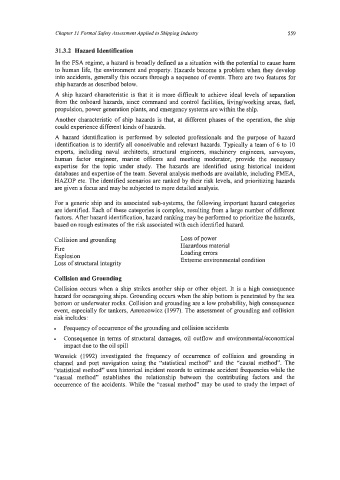Page 583 - Marine Structural Design
P. 583
Chapter 31 Formal Safev Assessment Applied to Shipping Industty 559
31.3.2 Hazard Identification
In the FSA regime, a hazard is broadly defined as a situation with the potential to cause harm
to human life, the environment and property. Hazards become a problem when they develop
into accidents, generally this occurs through a sequence of events. There are two features for
ship hazards as described below.
A ship hazard characteristic is that it is more difficult to achieve ideal levels of separation
from the onboard hazards, since command and control facilities, living/working areas, fuel,
propulsion, power generation plants, and emergency systems are within the ship.
Another characteristic of ship hazards is that, at different phases of the operation, the ship
could experience different kinds of hazards.
A hazard identification is performed by selected professionals and the purpose of hazard
identification is to identify all conceivable and relevant hazards. Typically a team of 6 to 10
experts, including naval architects, structural engineers, machinery engineers, surveyors,
human factor engineer, marine officers and meeting moderator, provide the necessary
expertise for the topic under study. The hazards are identified using historical incident
databases and expertise of the team. Several analysis methods are available, including FMEA,
HAZOP etc. The identified scenarios are ranked by their risk levels, and prioritizing hazards
are given a focus and may be subjected to more detailed analysis.
For a generic ship and its associated sub-systems, the following important hazard categories
are identified. Each of these categories is complex, resulting from a large number of different
factors. After hazard identification, hazard ranking may be performed to prioritize the hazards,
based on rough estimates of the risk associated with each identified hazard.
Collision and grounding Loss of power
Fire Hazardous material
Explosion Loading errors
Loss of structural integrity Extreme environmental condition
Collision and Grounding
Collision occurs when a ship strikes another ship or other object. It is a high consequence
hazard for oceangoing ships. Grounding occurs when the ship bottom is penetrated by the sea
bottom or underwater rocks. Collision and grounding are a low probability, high consequence
event, especially for tankers, Amrozowicz (1997). The assessment of grounding and collision
risk includes:
Frequency of occurrence of the grounding and collision accidents
Consequence in terms of structural damages, oil outflow and environmentaVeconomica1
impact due to the oil spill
Wennick (1992) investigated the frequency of occurrence of collision and grounding in
channel and port navigation using the “statistical method” and the “causal method”. The
“statistical method” uses historical incident records to estimate accident fi-equencies while the
“casual method” establishes the relationship between the contributing factors and the
occurrence of the accidents. While the “casual method” may be used to study the impact of

